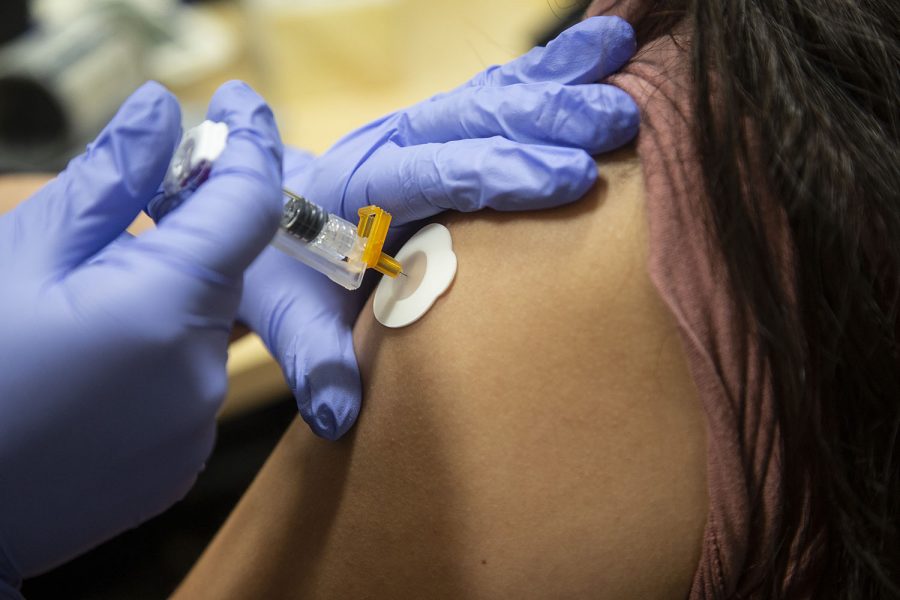Public health experts say COVID-19 safety precautions prevent flu
Experts point to COVID-19 safety precautions as the reason for the low incidence of the seasonal flu in Iowa.
Photo Illustration by Katie Goodale
February 16, 2021
University of Iowa and Johnson County Public Health officials say COVID-19 safety precautions have helped prevent the spread of the flu in Iowa.
This flu season, Iowa is seeing significantly fewer cases and deaths from the common flu. According to the Iowa Department of Public Health, the outpatient visits due to Influenza-Like Illness was 0.43 percent and there have only been four deaths due to the flu this year.
Johnson County Public Health Community Health Division Manager Sam Jarvis said this is likely due to an increase in good hand hygiene, people staying home when they’re sick, and more social distancing.
“The past several weeks, the flu has been notably lower in our area, the state, and even the nation,” Jarvis said. “I think it demonstrates that much of the precautions that we’re taking for COVID-19 are the same for flu, except we’re emphasizing them a bit more.”
UI Hospitals and Clinics Hospital Epidemiologist Jorge Salinas said following these safety precautions helps prevent the spread of almost all respiratory viruses, including the flu and COVID-19.
RELATED: Health care professionals recommend flu vaccinations during the coronavirus pandemic
Along with the safety measures, Jarvis said the heightened awareness for public health has played a role in slowing the spread of the flu.
“I think it’s also the behavior change — the heightened awareness — really plays a huge factor because there were plenty of persons before the pandemic who went to work ill,” Jarvis said. “With such attention and such focus on mitigation measures, there is a dramatic decrease in respiratory virus activity.”
Jarvis said another reason for this change is people getting flu shots.
As of Feb. 6, 1,237,750 doses of the seasonal flu vaccine have been administered in the state according to the Iowa Department of Public Health. This is relatively similar to the rate in years past, but the hospitalization rate is much lower.
At this time last year, there were about 100 people per 10,000 who were hospitalized because of the flu, compared to zero this year.
Iowa is also seeing lower rates of COVID-19 infection with a 4.8 percent positivity rate in the state and a six percent positivity rate in Johnson County, according to the Iowa coronavirus dashboard.
While these numbers and COVID-19 vaccines are promising, Jarvis said people need to continue to practice these measures.
RELATED: Iowa City leaders, University of Iowa professors express concern at end of statewide mask mandate
“Even with vaccines rolling out, it’s still to be determined on how much of an impact that will play,” Jarvis said. “Good hand hygiene, covering your cough, staying home when you’re ill, wearing a mask when around others – those things are playing an important role to keep community transmission low and that’s really important.”
The vaccine rollout continues and people in phase 1b are now receiving doses, as previously reported by The Daily Iowan. While public health experts are hopeful that this will have an impact on preventing COVID-19, UIHC Associate Hospital Epidemiologist Melanie Wellington said it’s important to continue to practice safety precautions.
“It’s unlikely but could happen that the vaccine prevents disease but not infection. If that’s the case, then when people get infected, they will have fewer or no symptoms, making it harder to figure out who’s got it,” Wellington said. “For the near future, we all need to be taking these safety measures even if we’re immunized.”
Before people can shed these safety measures, about 80 to 90 percent of Iowans need to be vaccinated and the incidence of COVID-19 needs to be relatively low, Salinas said.
Even after the pandemic, however, Salinas said he hopes people will take the pandemic as a lesson to continue these practice safety measures once it’s over.
“We can use lessons from this pandemic to decrease transmission of other respiratory infections in seasons to come,” Salinas said. “Possibly by wearing masks every winter.”






